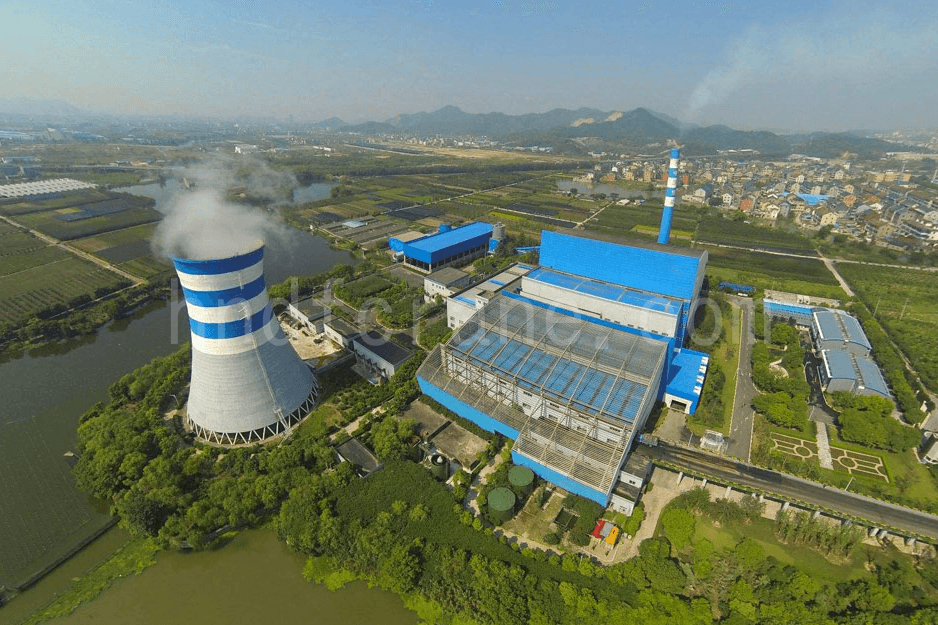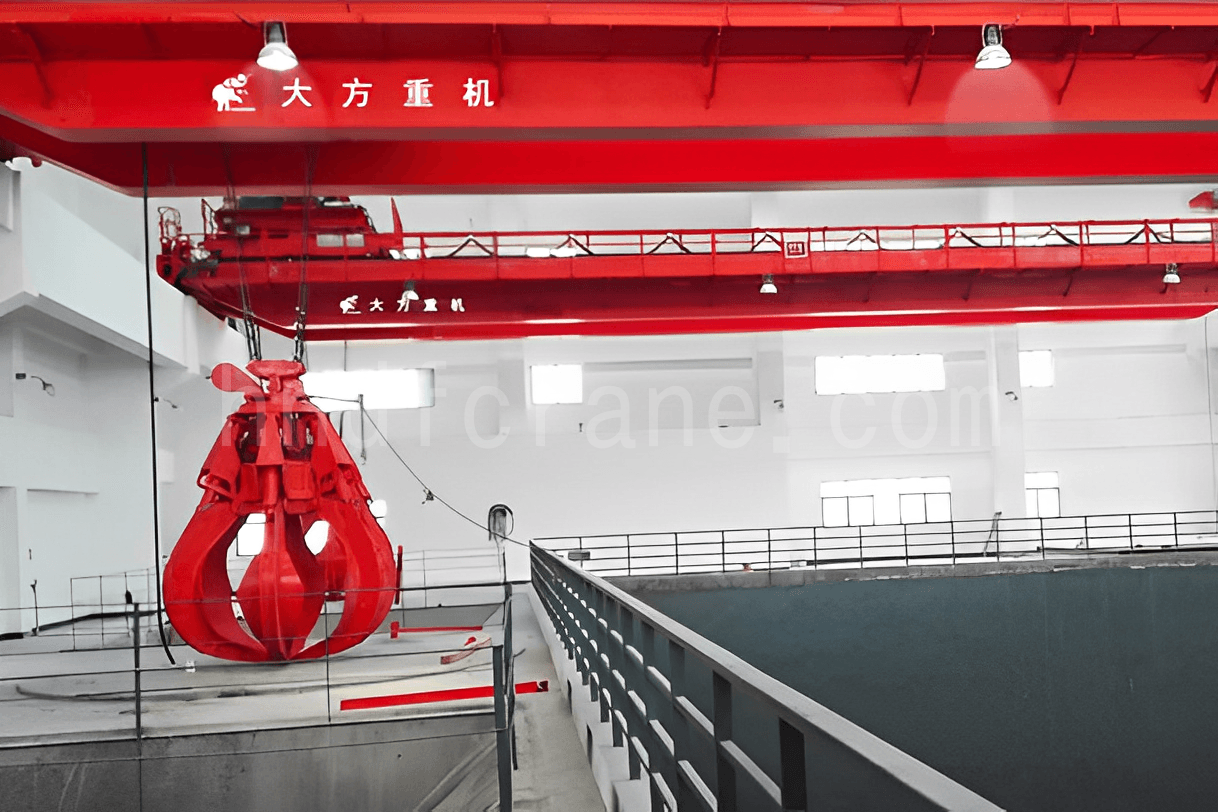เครนเหนือศีรษะสำหรับโรงงานแปรรูปขยะเป็นพลังงาน: คู่มือการกำหนดค่าและการเลือกที่จำเป็น
สารบัญ
เครนเหนือศีรษะมีบทบาทสำคัญในโรงงานแปรรูปขยะเป็นพลังงาน ซึ่งรวมถึงการจัดการวัสดุ การติดตั้งอุปกรณ์ และการบำรุงรักษา การกำหนดค่าเครนเหล่านี้อย่างเหมาะสมไม่เพียงแต่ช่วยเพิ่มประสิทธิภาพการทำงานของโรงงานเท่านั้น แต่ยังช่วยให้มั่นใจได้ถึงความปลอดภัยและเสถียรภาพในการผลิตอีกด้วย บทความนี้จะสำรวจการกำหนดค่าและบทบาทของเครนเหนือศีรษะของโรงงานแปรรูปขยะเป็นพลังงาน ซึ่งได้มาจากประสบการณ์ด้านวิศวกรรมหลายปี โดยให้ข้อมูลเชิงลึกอันมีค่าสำหรับการออกแบบและการดำเนินงานของโรงงานดังกล่าวทั่วโลก

I. การกำหนดค่าพื้นฐานของเครนในโรงงานแปรรูปขยะเป็นพลังงาน
ขนาดของโรงงานแปรรูปขยะเป็นพลังงานนั้นแตกต่างกันอย่างมาก ตั้งแต่โรงงานขนาดเล็กที่มีสายการผลิตเดียวที่แปรรูปได้ 300–500 ตันต่อวัน (t/d) ไปจนถึงโรงงานขนาดใหญ่ที่มีสายการผลิต 4–6 สายที่แปรรูปได้ 750–850 ตันต่อวันต่อสาย ตารางที่ 1 สรุปการกำหนดค่าและการติดตั้งเครนในโครงการที่มีอยู่ ข้อมูลระดับความสูงหมายถึงระดับความสูงของราง โดยปริมาตรถังจับที่มีประสิทธิภาพระบุไว้ในวงเล็บ
| เลขที่ | เครน | ประเภทเครน | โหมดการทำงาน | สถานที่ติดตั้ง | ความสามารถในการยก (Grab Bucket/m³) / ตัน | หน้าที่การงาน | หมายเหตุ |
|---|---|---|---|---|---|---|---|
| 1 | เครนคว้าขยะ | เครนเหนือศีรษะคานคู่ | ต่อเนื่อง 24 ชม./วัน (24 ชม./วัน) | เหนือบ่อขยะโดยตรง ความสูง 25–35 ม. | 11(6.3),12.5(8),18(10),20(12) | เอ8 | ไม่น้อยกว่า 2 หน่วย พร้อมสำรอง 1 หน่วย ไม่จำเป็นต้องมีคุณสมบัติป้องกันการระเบิด |
| 2 | เครนคว้าขี้เถ้า | เครนเหนือศีรษะคานคู่ | ต่อเนื่อง 8~12 ชม./วัน | เหนือหลุมตะกรันโดยตรง ความสูง 7–12 เมตร | 8(3.2),10(4) | A6~A8 | |
| 3 | การติดตั้งและบำรุงรักษากังหันน้ำเครน | เครนเหนือศีรษะแบบคานคู่ | เป็นระยะๆ | ภายในห้องกังหัน ความสูง 13–15 ม. | 20/5,25/5,32/5,50/10 | A3 | |
| 4 | เครนบำรุงรักษาห้องปั๊มแบบครบวงจร | เครนไฟฟ้าแบบคานเดี่ยวใต้คาน | เป็นระยะๆ | ภายในห้องปั๊มที่ครอบคลุม ความสูง 6–9 ม. | 2~3 | A3 | |
| 5 | เครนบำรุงรักษาพื้นที่เก็บเถ้าลอยชั่วคราว | เครนไฟฟ้าแบบคานเดี่ยวใต้คาน | เป็นระยะๆ | การบำรุงรักษาอุปกรณ์ภายในห้องเก็บเถ้าลอยชั่วคราว ความสูง 6–9 ม. | 2~3 | A3 | |
| 6 | งานซ่อมบำรุงเครื่องจักรยกไฟฟ้า | เครนไฟฟ้าแบบคานเดี่ยวใต้คาน | เป็นระยะๆ | บริเวณยอดอาคารสูง 6–8 เมตร | 2~5 | A3 | |
| 7 | เครื่องดูดฝุ่น Baghouse รอกไฟฟ้าบำรุงรักษา | เครนไฟฟ้าแบบคานเดี่ยวใต้คาน | เป็นระยะๆ | ตั้งอยู่บริเวณด้านบนของเครื่องดูดฝุ่นแบบถุงกรอง | 1~3 | A3 | |
| 8 | การบำรุงรักษาเครนคว้าขยะ รอกไฟฟ้า | เครนโมโนเรลไฟฟ้า | เป็นระยะๆ | เหนือเครนเก็บขยะโดยตรง ความสูง 32–40 เมตร | 3~5 | A3 | |
| 9 | การบำรุงรักษาพัดลมดูดอากาศเหนี่ยวนำรอกไฟฟ้า | เครนโมโนเรลไฟฟ้า | เป็นระยะๆ | เหนือพัดลมดูดอากาศโดยตรง ความสูง 7–10 เมตร | 5~10 | A3 | |
| 10 | การบำรุงรักษาเครื่องสูบน้ำป้อนน้ำ รอกไฟฟ้า | เครนโมโนเรลไฟฟ้า | เป็นระยะๆ | เหนือปั๊มน้ำป้อนโดยตรงในห้องกังหัน ความสูง 6–8 เมตร | 3~5 | A3 | |
| 11 | การบำรุงรักษาพัดลมระบายอากาศเบื้องต้น รอกไฟฟ้า | เครนโมโนเรลไฟฟ้า | เป็นระยะๆ | เหนือพัดลมระบายอากาศหลักโดยตรงในโรงงานเผาขยะ ความสูง 6–8 เมตร | 2~5 | A3 | |
| 12 | การบำรุงรักษาห้องคอมเพรสเซอร์ รอกไฟฟ้า | เครนโมโนเรลไฟฟ้า | เป็นระยะๆ | บริเวณด้านบนห้องคอมเพรสเซอร์ สูง 6–8 เมตร | 1~3 | A3 | |
| 13 | การบำรุงรักษาหม้อไอน้ำด้านบนรอกไฟฟ้า | เครนโมโนเรลไฟฟ้า | เป็นระยะๆ | บริเวณด้านบนของหม้อน้ำ เหนือระดับคานหม้อน้ำหลัก | 2~5 | A3 | |
| 14 | รอกไฟฟ้าบำรุงรักษาหอคอยขจัดกรด | เครนโมโนเรลไฟฟ้า | เป็นระยะๆ | เหนือระดับของหอขจัดกรดด้านบน | 1~3 | A3 | |
| 15 | การบำรุงรักษาปั๊มน้ำชะขยะ รอกไฟฟ้า | เครนโมโนเรลไฟฟ้า | เป็นระยะๆ | เหนือถังกรองน้ำซึม สูง -2 ถึง -5 เมตร | 1~3 | A3 | จำเป็นต้องมีการติดตั้งแบบป้องกันการระเบิด |
ตารางที่ 1: พารามิเตอร์ทางเทคนิคหลักของเครนในโรงงานแปรรูปขยะเป็นพลังงาน
II. ฟังก์ชั่นและการกำหนดค่าของเครนต่างๆ
เครนเหนือศีรษะคานคู่
(1)เครนขนถ่ายขยะ

หน้าที่ของ เครนขนของเสีย คือการจับ กอง ทิ้ง และป้อนขยะภายในหลุมขยะ โดยติดตั้งไว้เหนือหลุมขยะ โดยจุดที่ต่ำที่สุดของที่จับต้องได้ต้องอยู่ห่างจากระดับถังป้อนขยะอย่างน้อย 2 เมตร ห้องควบคุมเครนจับขยะจะอยู่ตรงข้ามหรือด้านข้างของถังขยะ เครนจับขยะและเครื่องเผาขยะต้องทำงานพร้อมกันเพื่อให้แน่ใจว่าโรงงานเผาขยะทำงานได้อย่างปลอดภัยและเสถียร มิฉะนั้น จะขัดขวางการป้อนขยะไปยังเครื่องเผาขยะ ซึ่งอาจทำให้โรงงานทั้งหมดต้องปิดตัวลง ดังนั้น เครนกำจัดขยะจึงเป็นอุปกรณ์หลักในโรงงานเผาขยะ ซึ่งต้องมีความแม่นยำ ความเสถียร และความน่าเชื่อถือสูงมาก ระดับการใช้งานต้องเป็นไปตามมาตรฐาน A8 และควรกำหนดค่าด้วยหน่วยทำงานหนึ่งหน่วยและหน่วยสแตนด์บายหนึ่งหน่วย
นอกจากนี้ เมื่อพิจารณาถึงสภาพแวดล้อมที่รุนแรง (เช่น ชื้น มีกรด มีก๊าซที่เป็นอันตราย เช่น CH4 และเอช2สิ่งสำคัญคือต้องใช้ส่วนประกอบที่โตเต็มที่และมีเสถียรภาพสำหรับระบบจับยึด ระบบไฮดรอลิก และส่วนประกอบไฟฟ้า จากประสบการณ์การทำงานหลายปี พบว่าความเข้มข้นของก๊าซไวไฟและระเบิดได้ในบริเวณที่เครนขนถ่ายขยะทำงานโดยทั่วไปจะไม่สูง และในกรณีส่วนใหญ่ ไม่จำเป็นต้องตั้งค่าป้องกันการระเบิด
(2) เครนคว้าขี้เถ้า
หน้าที่ของเครนจับขี้เถ้าคือการเคลื่อนย้ายตะกรันที่ระบายออกจากเตาเผาไปยังรถขนส่ง เมื่อเปรียบเทียบกับเครนจับขยะแล้ว ข้อกำหนดด้านประสิทธิภาพของเครนจับขี้เถ้าจะค่อนข้างต่ำกว่า เนื่องจากไม่จำเป็นต้องทำงานพร้อมกันกับเตาเผา เมื่อพิจารณาถึงปริมาตรที่จำกัดของหลุมตะกรัน จึงจำเป็นต้องใช้เวลาสูงสุดในการแก้ไขข้อบกพร่องในหลุมตะกรันไม่เกินหนึ่งวัน ห้องควบคุมของเครนจับขี้เถ้าโดยปกติจะอยู่ที่ด้านข้างหรือปลายหลุมตะกรัน และโรงงานเผาบางแห่งใช้รีโมทคอนโทรลในการทำงาน
โดยทั่วไปแล้ว ระดับหน้าที่ของเครนจับขี้เถ้าจะต่ำกว่าเครนจับขยะ โดย A6 ก็เพียงพอแล้ว อย่างไรก็ตาม ควรพิจารณาการกำหนดค่าจริงของหน่วยและถังเก็บตะกรันด้วย โดยทั่วไป โรงงานเผาที่มีสายเผามากกว่า 2 สายควรใช้ระดับหน้าที่ A7 หรือ A8 สำหรับโรงงานเผาขนาดใหญ่ที่มีสายเผา 4 สาย เมื่อพิจารณาจากความกว้างของพื้นที่เก็บตะกรันที่มาก ควรใช้เครนจับขี้เถ้า 2 ตัว
เครนเหนือศีรษะคานคู่

เดอะ เครนเหนือศีรษะแบบคานคู่ หมายถึงเครนติดตั้งและบำรุงรักษากังหัน (ต่อไปนี้จะเรียกว่าเครนกังหัน) หน้าที่หลักคือการติดตั้งและบำรุงรักษากังหันและเครื่องกำเนิดไฟฟ้า ซึ่งแตกต่างจากเครนจับขยะและเครนจับเถ้า เครนกังหันจะใช้เฉพาะหลังจากที่โรงงานดำเนินการแล้วเท่านั้น เนื่องจากหน่วยกังหันและเครื่องกำเนิดไฟฟ้ามีขนาดใหญ่และมวลมาก จึงมักจะขนส่งไปยังโรงงานแปรรูปขยะเป็นพลังงานในส่วนที่แยกจากโรงงานผลิต จากนั้นจึงใช้เครนกังหันในการยกและติดตั้งส่วนประกอบของกังหันและเครื่องกำเนิดไฟฟ้า หลังจากติดตั้งแล้ว ต้องใช้เครนกังหันเป็นประจำเพื่อบำรุงรักษาและตรวจสอบกังหันและเครื่องกำเนิดไฟฟ้า เครนจะต้องทำงานเต็มประสิทธิภาพอย่างน้อยปีละสองครั้ง (2 ครั้ง/ปี)
เครนไฟฟ้าแบบคานเดี่ยวใต้คาน
เครนยกใต้คานเดี่ยวแบบไฟฟ้ามีหน้าที่หลักในการบำรุงรักษาและตรวจสอบห้องปั๊ม ห้องเก็บเถ้าชั่วคราว ห้องปฏิบัติงาน และตัวเก็บฝุ่นแบบถุงกรอง การออกแบบห้องเหล่านี้ต้องการให้รอกมีฟังก์ชันการยก รถเข็น และการเคลื่อนที่ของเครน ตัวอย่างเช่น ในตัวเก็บฝุ่นแบบถุงกรอง ส่วนประกอบต่างๆ เช่น ตัวทำความสะอาดเถ้าและกรงถุงกรอง จะต้องถูกยกขึ้นและวางให้ทั่วพื้นผิวการทำงานทั้งหมด รอกจะต้องเข้าถึงทุกพื้นที่ของพื้นที่ทำงาน และควรใช้รอกบำรุงรักษาอย่างน้อยปีละสองครั้ง (2 ครั้ง/ปี)
เครนโมโนเรลไฟฟ้า
เส้นทางของกระแสไฟฟ้า รถเครนโมโนเรล ค่อนข้างเรียบง่าย และส่วนใหญ่ใช้สำหรับการยกและขนส่งอุปกรณ์หนักที่ติดตั้งอยู่กับที่ เช่น พัดลม ปั๊ม และเครื่องจักรหมุนอื่นๆ ความสามารถในการยกสูงสุดไม่เกิน 10 ตัน โดยส่วนใหญ่ต้องเคลื่อนที่ไปตามรางทิศทางเดียว ในขณะที่บางส่วนต้องการเพียงฟังก์ชันการยกเท่านั้น สิ่งสำคัญคือต้องทราบว่าในบางพื้นที่ อาจมีก๊าซไวไฟและระเบิดได้ เช่น H2S, CO และ NH3ซึ่งต้องใช้มอเตอร์ป้องกันการระเบิด
III. วิธีการเลือกเครนสำหรับโรงไฟฟ้าพลังงานขยะ
ในโรงงานแปรรูปพลังงานจากขยะมีเครนหลายชุด โดยแต่ละชุดมีความแตกต่างกันอย่างมากในด้านประเภท ความสามารถในการยก ข้อกำหนดทางเทคนิค และเค้าโครง รายการ 1 ถึง 3 ในตาราง 1 โดยทั่วไปจะแสดงถึงการกำหนดค่ามาตรฐานสำหรับโรงงานแปรรูปพลังงานจากขยะ ในขณะที่อุปกรณ์อื่นๆ จะถูกกำหนดขึ้นโดยอิงตามขนาดของโรงงาน การกำหนดค่าอุปกรณ์ และข้อกำหนดของเจ้าของ
เครนสามารถแบ่งออกได้เป็นอุปกรณ์ปฏิบัติการและอุปกรณ์บำรุงรักษาตามหน้าที่การใช้งาน ทั้งเครนคว้าขยะและเครนคว้าขี้เถ้าจัดอยู่ในกลุ่มอุปกรณ์ปฏิบัติการซึ่งต้องทำงานทุกวัน โดยเฉพาะอย่างยิ่ง เครนคว้าขยะจะต้องทำงานอย่างต่อเนื่องด้วยความแม่นยำและมีเสถียรภาพ และจำเป็นต้องมีเครนอย่างน้อย 2 ชุด โครงการส่วนใหญ่ยังต้องการเครนคว้าสำรองเพิ่มเติมเพื่อให้แน่ใจว่าการทำงานจะไม่หยุดชะงักเนื่องจากเครนคว้าขยะทำงานผิดปกติ เครนบำรุงรักษามีการใช้งานน้อยลง และข้อกำหนดด้านสิ่งแวดล้อมก็แตกต่างกันไป
(1) ความสามารถในการยกสูงสุดของเครนจับขยะจะถูกกำหนดโดยการกำหนดค่าหน่วยของโครงการ ความสามารถในการประมวลผล และเค้าโครงของหลุมขยะ จากการออกแบบโครงการก่อนหน้านี้ ความสามารถในการยกและปริมาตรถังจับสำหรับเครนจับขยะและเครนจับขี้เถ้าจะสรุปไว้ในตารางด้านล่าง
| เครื่องชั่งประมวลผล | เครนขนขยะ / เครนขนขี้เถ้า | |||
|---|---|---|---|---|
| ความสามารถในการประมวลผลรวม (ตัน/วัน) | จำนวนสายการเผาไหม้ | ความสามารถในการยก (ตัน) | ปริมาตรถังเก็บ (ม³) | จำนวนหน่วย |
| ≤600 | ≤2 | 11/8 | 6.3/3.2 | 2/1 |
| 600 | ≤3 | 12.5/8 | 8/3.2 | 2/1หรือ2 |
| 1200 | 2≤สายการเผาไหม้≤3 | 18/8 | 10/3.2 | 2/2 |
| 1800 | 2≤สายการเผาไหม้≤4 | 18/10 | 10/4 | 3/2 |
| 2400 | ≤4 | 18/10 | 10/4 | 4/2 |
| 2400 | ≤4 | 20/10 | 12/4 | 3/2 |
(2) ความสามารถในการยกของเครนกังหันนั้นสัมพันธ์กับน้ำหนักสูงสุดของส่วนประกอบแต่ละชิ้นในระหว่างการขนถ่ายและติดตั้งเครื่องกำเนิดไฟฟ้า จากประสบการณ์ที่สะสมมา สำหรับหน่วยผลิตพลังงานจากขยะที่มีกำลังการผลิตต่ำกว่า 30 เมกะวัตต์และมีน้อยกว่า 3 หน่วย โดยทั่วไปจะเลือกใช้เครนกังหันตัวเดียว เมื่อจำนวนหน่วยเท่ากับหรือมากกว่า 3 หน่วย อาจแนะนำให้เลือกใช้เครนกังหัน 2 ตัว (ตัวหนึ่งใหญ่และอีกตัวหนึ่งเล็ก)
(3) ความสามารถในการยกของเครนบำรุงรักษาอื่นๆ (รายการ 4–15 ในตาราง 1) ขึ้นอยู่กับน้ำหนักสูงสุดของอุปกรณ์ที่ต้องซ่อมบำรุง ปัจจัยที่พิจารณาเมื่อตัดสินใจว่าจำเป็นต้องใช้เครนยกของนั้นแตกต่างกันออกไป:
- น้ำหนักสูงสุดของพัดลมดูดอากาศหลักและพัดลมดูดอากาศเหนี่ยวนำนั้นสัมพันธ์อย่างใกล้ชิดกับความสามารถในการประมวลผลของเตาเผาแต่ละเตา เนื่องจากเตาเผาและพัดลมทำงานแบบหนึ่งต่อหนึ่ง ยิ่งความสามารถในการประมวลผลของเตาเผาแต่ละเตามีขนาดใหญ่เท่าใด ความต้องการอากาศและการระบายอากาศก็จะมากขึ้นเท่านั้น ซึ่งจะทำให้ขนาดและน้ำหนักของอุปกรณ์พัดลมเพิ่มขึ้นตามไปด้วย จากประสบการณ์ด้านโครงการวิศวกรรม ขอแนะนำให้ติดตั้งรอกบำรุงรักษาสำหรับพัดลมดูดอากาศหลักและพัดลมดูดอากาศเหนี่ยวนำที่เกี่ยวข้องกับเตาเผาที่ประมวลผลมากกว่า 600 ตัน/วัน
- ความจำเป็นในการบำรุงรักษาเครื่องยกสำหรับปั๊มน้ำป้อนและคอมเพรสเซอร์ไม่ได้เกี่ยวข้องโดยตรงกับความสามารถในการประมวลผล การตัดสินใจขึ้นอยู่กับน้ำหนักสูงสุดของอุปกรณ์
- รอกประเภทอื่น เช่น รอกสำหรับหอขจัดกรด รอกเก็บฝุ่น และรอกบนหม้อไอน้ำ มักถูกวางไว้ในที่สูงเพื่อป้องกันการตกและเพื่อความปลอดภัยของคนงาน
- ปั๊มน้ำซึมตั้งอยู่ในพื้นที่ปิดที่เต็มไปด้วยความชื้น ความร้อน และก๊าซอันตราย ทำให้การเพิ่มเครื่องยกบำรุงรักษาช่วยลดภาระงานและเพิ่มความปลอดภัยให้กับเจ้าหน้าที่บำรุงรักษา
โดยทั่วไป การกำหนดค่าของเครนบำรุงรักษาในช่วงนี้จะคล้ายคลึงกับของโรงงานอุตสาหกรรมอื่นๆ (เช่น โรงบำบัดน้ำเสีย โรงไฟฟ้าพลังความร้อน โรงงานเคมี และโรงงานเหล็ก) เป้าหมายหลักคือการตอบสนองความต้องการในการบำรุงรักษาอุปกรณ์ ลดเวลาการบำรุงรักษา และลดความเข้มข้นของแรงงาน เมื่อเลือกเครนขนาดเล็กสำหรับการใช้งานเหล่านี้ คุณลักษณะของโรงงานแปรรูปขยะไม่มีผลอย่างมากต่อการเลือกเครน วิศวกรสามารถกำหนดค่าเครนตามมาตรฐานแห่งชาติหรืออุตสาหกรรมที่เกี่ยวข้องและสภาพสถานที่
อ้างอิง: การกำหนดค่าเครนสำหรับโรงงานแปรรูปขยะเป็นพลังงาน
ส่งคำถามของคุณ
- อีเมล: sales@hndfcrane.com
- วอทส์แอพพ์: +86-191 3738 6654
- โทร: +86-373-581 8299
- แฟกซ์: +86-373-215 7000
- เพิ่ม: Changnao Industrial District, Xinxiang City, Henan Province, China








































































